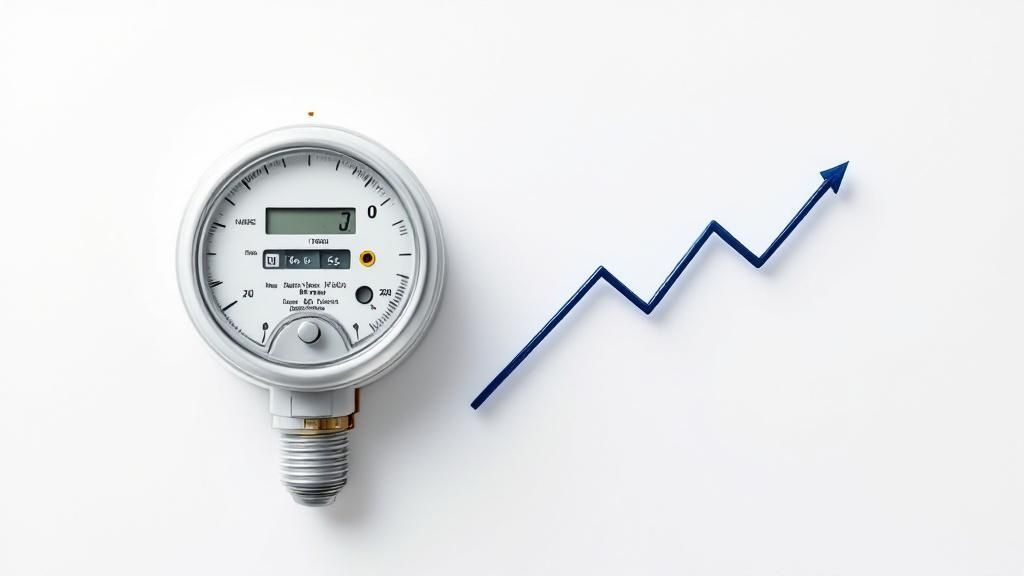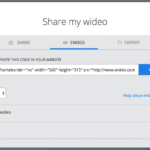The way utilities have traditionally talked to customers just isn’t working anymore. For a long time, utilities marketing was all about dry, reactive alerts and basic billing messages. But customer expectations have shifted dramatically, creating a disconnect between providers and the people they serve. People now want clearer, faster, and more human communication from the companies that power their lives.
This isn’t a crisis; it’s an opportunity. For marketing and communications teams, this is a chance to move beyond transactional messaging and start building real, lasting connections. It’s time to modernize how you communicate, not just what you say.

Think about it. For decades, the relationship between a utility and its customers was purely functional. The power, gas, or water came on, a bill showed up, and that was about it. Communication was minimal, usually just impersonal outage notices or dense mailers filled with jargon nobody understood.
But that’s no longer the world we live in. Your customers interact with brands like Netflix, Amazon, and Spotify every day. These companies deliver clear, proactive, and deeply personal experiences. They anticipate needs, offer helpful suggestions, and communicate like a real person. As a result, people now expect this kind of thoughtful service from every organization, including their utility provider.
Suddenly, the old, sterile approach feels frustrating and out of touch. Customers don’t just want their lights to turn on; they want a partner who helps them understand their energy use, find ways to save money, and make sense of service changes without a headache.
The Growing Disconnect
This gap between what people expect and what they get is where traditional utilities marketing stumbles. The industry itself is in the middle of a massive overhaul. You can dive deeper into the market trends shaping the utilities sector, but there’s a catch: the communication strategies haven’t kept pace.
The core problem is this: Utilities are investing billions in modernizing the grid but are often still using decades-old methods to talk to their customers about it. This creates a trust gap that no amount of infrastructure can fix on its own.
Modernizing what you say and how you say it is every bit as critical as updating the physical grid. Your customers need, and deserve, better.
It’s Time to Reimagine Your Mindset
The good news is that this challenge is a huge opportunity. By shifting from a reactive, transactional mindset to a creative and proactive one, you can completely reshape your customer relationships. It’s about getting past simply informing people and starting to actively engage them.
Imagine your communications being not just tolerated, but actually welcomed. This isn’t a fantasy; it’s achievable by rethinking the entire playbook. Here are a few creative marketing ideas to get you started:
- Humanized Customer Stories: Don’t just talk about your service. Show its real-world impact by telling the stories of the families and local businesses you power.
- Educational Campaigns: Create simple, clear content that breaks down a confusing bill, explains energy usage, or offers practical tips for saving money.
- Content Tailored by Community: Tailor your messages to specific neighborhoods. This shows you understand their unique needs and aren’t just sending out generic blasts.
- Engaging Real-Time Updates: Turn outage and maintenance news into something genuinely helpful and easy to follow, using modern formats people actually like.
- Personalized Videos: Use short, friendly videos to welcome new customers, explain a change to their plan, or even just say thanks.
When you start using creative and empathetic strategies, you build real trust. You stop being a faceless service provider and become an essential community partner. The future of utilities marketing is all about building those connections, one clear and human message at a time.
Winning Back Customer Attention
Ever wonder why customers seem to tune you out? It’s not their fault, it’s usually a breakdown in how we communicate. For too long, our industry has relied on messages that are confusing, impersonal, and frankly, a chore to read.
Think about the last bill you sent. Was it a clean, simple document, or a wall of numbers that felt like it needed a decoder ring? What about that last outage alert? Did it sound like a robot, or was it a genuinely helpful update that offered reassurance? These small interactions add up, creating a feeling of frustration and, eventually, apathy.
Customers aren’t ignoring you because they don’t care; they’re tuning out because the communication feels like it wasn’t designed for them in the first place. Corporate jargon and sterile language create distance, making you feel more like a faceless institution than a vital community partner.
Shifting from Provider to Partner
The real way to win back attention starts with a complete shift in mindset. You have to stop thinking of your organization as just a service provider and start acting like a helpful, transparent resource. To get their attention, you have to embrace modern digital marketing approaches that are proactive, helpful, and above all, human.
Just compare a jargon-stuffed mailer about rate changes to a short, friendly video that clearly explains why the changes are happening and what it means for their bill. One is heading for the recycling bin, while the other builds real understanding and trust.
Building Trust Through Transparency and Helpfulness
Trust is earned through consistent, clear communication. Every message you send is a chance to either build that trust or weaken it. Instead of seeing communication as just a box to check, see it as your most powerful tool for building a positive relationship.
Here’s how you can start making that pivot:
- Deconstruct the Bill: Your monthly bill is often the most frequent touchpoint you have. Turn it into an opportunity for education, not confusion. Use plain language, simple visuals, and maybe even a link to a short explainer video.
- Explain the ‘Why’: When maintenance is coming or rates are changing, don’t just state the fact. Explain the reason behind it. A simple, “We’re upgrading equipment in your neighborhood to improve reliability” goes a surprisingly long way.
- Become a Source of Value: Offer proactive tips on saving energy, home safety, or how to use new programs. This positions you as a helpful expert who is looking out for their best interests.
By focusing on clarity and value, you completely change the dynamic. You’re no longer just sending a demand for payment; you’re providing a service update that includes helpful context and shows you’re committed to your customers’ well-being.
Ultimately, winning back attention isn’t about flashy campaigns. It’s about a commitment to empathy. It’s about constantly asking, “How can we make this easier to understand? How can we make this more helpful?” For a deeper look into this strategy, you might be interested in our guide on why you should use video for marketing to make your messages more engaging. By answering these questions with every single communication, you’ll start to capture not just attention, but genuine loyalty.
Creative Strategies to Build Real Connections

So, how do you put this into practice? Shifting from a transactional provider to a true partner demands creative, tangible strategies that change how you communicate. Effective utilities marketing has moved beyond broadcasting messages. It’s now about starting conversations and delivering real value. The ideas that follow are designed to get your team thinking beyond dry updates so you can start building lasting connections. For a deeper dive into this, exploring techniques for maximizing customer engagement with customer journey software can provide a significant edge.
Humanize Your Impact with Customer Stories
Facts and figures about grid reliability are important, but they don’t exactly pull at the heartstrings. Stories do. Your service is the invisible thread weaving through your customers’ lives, powering everything from a small business’s “Open” sign to a family’s movie night. It’s time to make that impact visible.
Stop talking only about infrastructure and start telling the human stories behind it. Feature a local restaurant owner who depends on your consistent service. Interview a family who used your energy-saving tips to lower their bill. These narratives transform your utility from a faceless entity into an invested community partner.
Key Takeaway: A story about one family saving money is far more powerful than a statistic about thousands. It makes the benefit tangible and relatable, building a strong emotional connection to your brand.
Launch Proactive Educational Campaigns
Confusion is the enemy of trust. When customers can’t make sense of their bill or a service change, they get frustrated. Proactive education is your best tool for demystifying complex topics and empowering your customers.
Don’t wait for them to call with questions. Get out ahead of their concerns with clear, simple educational content.
- Deconstruct the Bill: Create a simple visual guide or a short animated video that walks through each section of the monthly statement. Explain what terms like “kWh” or “delivery charges” actually mean in plain English.
- Seasonal Energy-Saving Tips: Send out timely advice before a heatwave or cold snap hits. Offer practical, easy-to-implement tips that help customers manage their usage.
- Explain New Technologies: Rolling out smart meters? Develop a small, focused campaign to explain the benefits and show how to use the new tech.
Tailor Content for Local Relevance
A one-size-fits-all message rarely fits anyone. Your service area is a patchwork of diverse communities. Generic, corporate-wide communications feel impersonal. Hyper-local content shows you see and care about the specific neighborhoods you serve.
For example, if you’re doing infrastructure work in a particular part of town, create content just for those residents. Introduce the local crew supervisor with a short “meet the team” video. Explain exactly which streets will be affected and why the work is critical for their future reliability. This kind of targeted communication builds an incredible amount of local goodwill.
Shifting From Transactional to Relational Messaging
| Traditional Tactic (Transactional) | Modern Strategy (Relational) | Customer Impact |
|---|---|---|
| Generic bill alert emails. | Personalized video explaining a high bill. | Reduces anxiety and builds trust. |
| Robotic outage text: “Outage reported.” | Proactive update with a map and ETA. | Provides peace of mind and transparency. |
| A dense PDF about energy-saving. | A short, animated video with 3 quick tips. | Increases engagement and action. |
| A press release about grid upgrades. | A story featuring a local business that benefits. | Creates an emotional connection. |
This shift demonstrates empathy and shows that you see customers as people, not just account numbers.
Reimagine Outage and Maintenance Updates
Nothing stress-tests a customer relationship quite like a service outage. The traditional, robotic text alert: “Outage in your area. No ETA.”, only cranks up anxiety. This is a moment where you can either alienate customers or demonstrate real empathy.
It’s time to upgrade your outage updates from sterile notifications to valuable, reassuring resources:
- Real-Time Maps: Use interactive maps that show the outage boundaries and how many neighbors are affected.
- Clear ETAs: Provide estimated restoration times and update them regularly, even if it’s just to say crews are still on it.
- Visual Progress: When it’s safe, share a quick photo or video clip of crews on-site making repairs. Seeing is believing.
Use Personalized Video to Connect Directly
In a world flooded with mass emails, a personal touch cuts through the noise. Short, personalized videos are an incredibly powerful way to make your customers feel seen and valued. They deliver messages in a format that’s easy to digest and feels authentically human. As you build out your strategy, it’s worth learning how to use personalized video to win customers and adapting those principles.
Think about creating simple, automated videos for key moments in the customer journey:
- Welcome Videos: Send new customers a short video welcoming them to your service, with their name appearing right in the video.
- Milestone Thank-Yous: Celebrate a customer’s 5- or 10-year anniversary with a quick “thank you” video.
- Program Onboarding: When someone signs up for a new program, send a video that walks them through the next steps.
Platforms like Wideo’s utilities video solution make it surprisingly simple for marketing teams to create these kinds of professional, on-brand videos without a full film crew. By embracing this approach, you can modernize not just what you say, but how you say it, turning routine communications into memorable, positive interactions.
Using Video to Humanize Your Utility
Sure, emails and PDFs have their place, but they rarely get anyone excited. In a field like utilities, where topics can be technical or dry, video is your best bet for adding a much-needed human touch. It transforms complex information into something digestible, relatable, and memorable.
What’s going to make a bigger impact? A long-winded mailer explaining a rate change, or a 60-second animated video that breaks down the why behind it? Video cuts through the noise, making utilities marketing more engaging and effective.
Making Complex Topics Simple and Relatable
Video has a knack for making complicated things feel simple. By combining visuals, a friendly voice, and clear text, it can explain concepts in a way that static words on a page just can’t. This makes it the perfect medium for a utility company trying to proactively educate its customers.
Here are a few types of videos that can make your utility’s information more digestible and relatable:
- Animated Explainer Videos: These are gold for breaking down tricky subjects like billing cycles, energy efficiency programs, or how the power grid works.
- Onboarding and Welcome Videos: A short, welcoming video is a fantastic personal touch that shows you value a new customer from day one.
- “Meet the Crew” Features: A quick video introducing the local team handling maintenance in a neighborhood builds a genuine community connection.
Communicating Change and Building Trust
The energy sector is modernizing, which means customers will see some significant shifts. You can explore more about these utility sector trends and technologies to get a sense of just how vital clear communication will be.
Video is the essential tool for explaining these changes in a way that’s clear and reassuring, not alarming.
A sincere video message from your company’s leadership during a crisis or major change can build more trust in two minutes than a dozen press releases. It shows accountability and empathy in a way that feels direct and unscripted.
This human touch is also incredibly powerful for your internal teams. Keeping employees informed and engaged with video helps ensure everyone is on the same page and delivering a consistent, positive customer experience. In fact, there are plenty of great reasons to use video in your internal communications strategy that directly support your external marketing goals.
Inspiring Examples of Modern Utilities Marketing
It’s one thing to talk about changing how you communicate, but it’s another to see it in action. The shift away from dry, reactive updates toward creative, proactive engagement isn’t just a theory, it’s already happening. Forward-thinking utilities are proving that a human-centered approach to utilities marketing delivers powerful results.
These examples aren’t about massive campaigns. They’re about smart, strategic pivots that put the customer first. By focusing on real-world problems and offering genuine help, these companies are rewriting the playbook for an entire industry.
Proactive Assistance through Smart Data
One of the biggest game-changers is using data to help customers before they even realize there’s a problem. Instead of waiting for an angry call about a shockingly high bill, leading utilities are getting out ahead of the issue.
This is where technology like artificial intelligence comes into play. Some providers now use AI to personalize their outreach, identifying customers who might see a spike in their summer bill and proactively offering assistance programs or energy-saving tips. This AI-driven, proactive approach is quickly becoming the new gold standard. You can read more about how AI is shaping 2025 utility marketing trends to see just how important this is becoming.
By turning data into a tool for empathy, you can transform a potential negative interaction into a positive, supportive one.
Making Outage Updates Genuinely Helpful
Nothing tests customer trust quite like a power outage. For years, the standard response was a vague, robotic text. Today, the best utility marketers are turning this critical moment into a masterclass in transparent communication.
Take Florida Power & Light (FPL), for instance. Their online Power Tracker map is a perfect example of doing it right. During an outage, customers can see:
- A live map showing exactly which areas are affected.
- The number of customers impacted.
- The cause of the outage (when it’s known).
- A clear Estimated Time of Restoration (ETR).
This level of detail provides immediate peace of mind. It shows respect for the customer’s time and concern, proving that the utility is actively working on the problem.
Personalized Video for a Human Touch
Imagine you’re a new customer and you get a welcome email. Now, imagine that email contains a short, friendly video that says, “Welcome, Sarah!” and gives you a quick tour of your online account. The difference is night and day.
Utilities are now using personalized video to create these memorable moments at scale. These short, automated videos can be triggered by specific customer actions, making every communication feel individual and thoughtful.
A personalized video explaining a higher-than-usual bill, for instance, can de-escalate frustration before it even starts. It shows you recognize the customer’s specific situation and are there to help them understand it, building a bridge of trust where a wall of confusion used to be.
Wideo’s utilities Video Automation is designed to help marketing teams produce these professional, on-brand videos without needing a film crew. It’s a powerful way to humanize your brand and turn routine interactions into real opportunities for connection.
Your Blueprint for Building Customer Trust
Making the leap from a simple service provider to a genuinely trusted community partner can feel like a huge undertaking. But it doesn’t have to be. The future of utilities marketing is built on real, human connection, and this blueprint is your map to get there. It’s all about making small, deliberate changes that, over time, completely reshape how customers see and interact with you.
This kind of transformation doesn’t mean you need to tear down everything and start from scratch. It actually starts much smaller. Just pick a single, high-impact area to improve. Get one thing right, and do it exceptionally well. This creates momentum and makes the bigger picture feel much more achievable.
Your First Steps to Building Momentum
Start with the low-hanging fruit, the small tweaks that offer the most visible and immediate improvements to the customer experience.
Not sure where to begin? Try one of these starting points:
- Revamp Your Outage Alerts: Ditch the cold, robotic notifications for good. Redesign your outage communications to include real-time maps, clearer ETAs, and a much more empathetic, human tone.
- Create One Educational Video: Think about the single most common question your call center gets. Now, create a simple, two-minute animated video that explains the answer clearly.
- Humanize a Single Campaign: The next time you need to announce routine maintenance, build the campaign around the local crew doing the work. A quick “meet the team” post can transform the tone from an inconvenience to a community update.
Reinforcing Your Role in the Community
As you start to build these new communication habits, it’s critical to make sure every message aligns with a consistent and trustworthy persona. This reinforces the idea that you’re not just a utility, but an essential part of the community’s fabric. A key part of your blueprint for building trust is creating a cohesive brand identity that feels authentic and resonates with the people you serve.
The goal is simple: leave your customers feeling informed, respected, and supported. Every single communication, from a bill notification to a major service announcement, is a chance to prove you’re on their side.
Ultimately, this blueprint is about more than just marketing. It’s about fundamentally rewiring the customer relationship for the better. By taking these first practical steps, your team can lead the charge in modernizing your organization’s entire communication strategy. Check out Wideo’s utilities video solution and start building stronger connections with your customers today.





